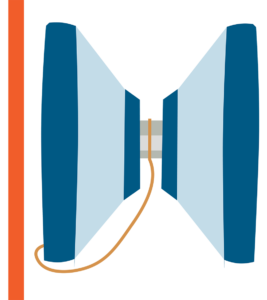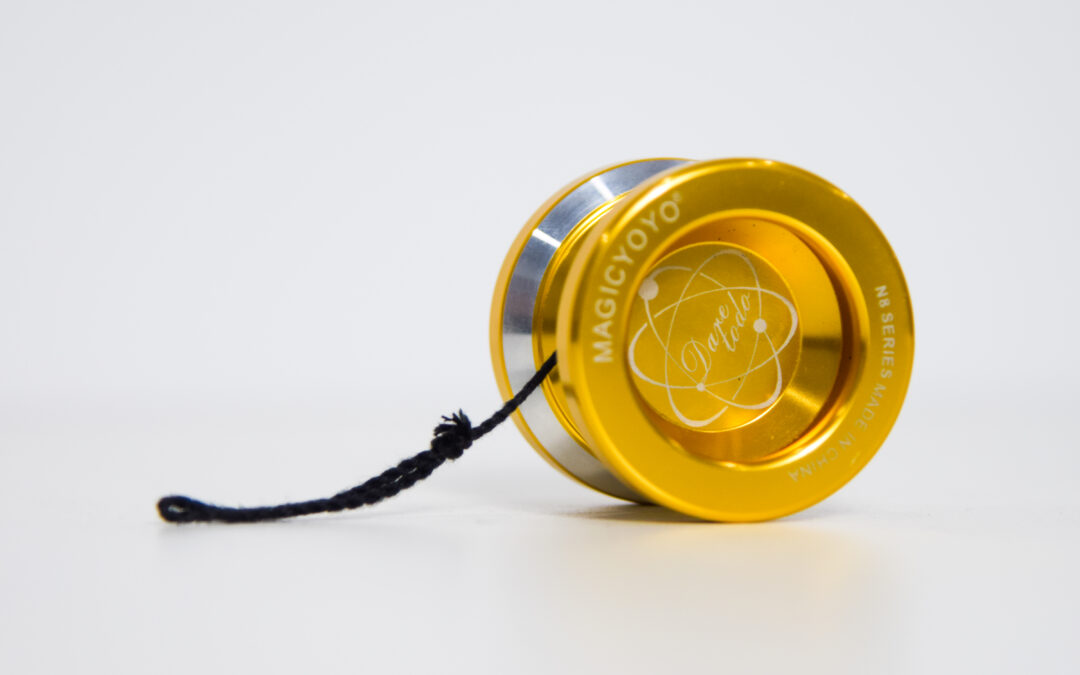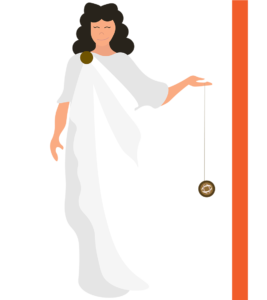![]()
This Iconic Plastic Product is the ultimate rotational device (other then our moulding machines, of course): the Yo-yo.
Akin to the building block (or the ‘Lego’) in both its ancient origins and universal, ageless popularity, this children’s toy has developed a significantly large following over its long history, even amongst adults. Brilliant in its simplicity, we will be exploring the ups and downs of the Yo-yo, from development to design.
Date of Invention:
The first sightings of the Yo-yo dates back to 500 B.C. in Ancient Greece, and were made from wood or metal, usually decorated with pictures of Gods. They were called a variety of names during this time, such as “bandalores” or “quizzes”.
It first travelled to America in 1923, made by hand by a Philippine man named Pedro Flores. He was the man who coined the name “Yo-yo”, supposedly meaning “come-come” in the native Philippine language. Perhaps due to this, many rumours were spread about the Yo-yo’s origin, with claims they were weapons for the native Philippines. However this has been firmly debunked.
Nevertheless, Pedro Flores ensured this toy’s place in the children’s toys hall of fame. Pedro founded a Yo-yo making factory, which was eventually sold a to Donald F. Duncan in 1930. In 1955, they began to make Yo-yo’s out of plastic, reaching the height of their popularity in the 1960’s. Even JFK was known for playing with Yo-yo’s in the White House.
Today it is still one of the most popular toys, for both adult and children alike. Yo-yo’s have an extremely popular fanbase who regularly participate in the ancient sport of “Yo-yoing”. Collectors can spend hundreds of dollars on Yo-yos which are rare, vintage or retro. There are museums, exhibits and conventions where Yo-yo fans assemble to collectively Yo-yo.
Holiday:
National Yo-Yo Day is on June 6th, in what was a slightly failed tribute to the birthday of Donald. F. Duncan (his birthday was actually on the 8th, but the sentiment is there).
You can celebrate this holiday by picking up a Yo-yo and learning a new trick, or teaching a friend how to Yo-yo! You can even make your own Yo-yo out of items found in your household’s recycling bin. You can read a step-by-step instructions here.
Yo-yoing is also a competitive sport with proper coaching and techniques for hand and finger movements, positioning, posture, timing and string or trick pattern. However, the main purpose of the Yo-yo is to have fun, so hold your own festive competition for fun with your family and friends!
You can also follow the holiday at #NationalYoYoDay or #todaysthrow. Share your own Yo-yoing skills with the rest of the Yo-yo community around the world!
Plastic type:
Yo-yo’s are typically made from Polycarbonate, ABS or Delrin/Celcon. They can also be made from “Heavy Gravity”, which is a plastic saturated with metal powder, and is more dense than other plastics.
Design:
Original Yo-yos were made from wooden, terracotta or metal discs with a simple string. Today though, the whole science of the Yo-yo has been successfully unpacked by the Yo-yoing experts, and so the design has been significantly improved.

Traditional Yo-yo designs secured the string to the axle by simply knotting it tightly around its circumference, however modern interpretations utilize a loop system, which allows the Yoyo the “sleep”, or continue spinning freely by reducing the applied grip and friction. This is further enhanced by the eventual change in the type of string used, going from single tied to double stringed. Some Yo-yo’s also began using the ball bearing assembly around the axel, which separates the axel from the string and further reduces friction.
There have been substantial debates regarding the superior material for the Yo-yo. There are forums which go into details about the contradicting opinions, such as that of “plastic VS metal Yoyos”.
Some of the mentioned benefits of plastic Yo-yos include price, aesthetic durability, and what is described as a “floaty feeling” in one’s Yo-yoing performance, which improves a person’s control to the product. However, it’s not ideal for fast Yo-yoing, and the slippery plastic material does not bare well with sweaty hands.
Yo-yos seem magical; the sight of something rising and falling on a string, almost as if floating, seems to defy gravity. But the Yo-yo’s function is the result of clever design and the principles of physics, specifically potential energy (or stored energy) and kinetic energy (motion).
A Yo-yo held in your hand, positioned relatively high off the ground, is filled with potential energy. When the Yo-yo is released, it is converted into kinetic energy. As it bounces up and down the string, it is simply exchanging potential and kinetic energies. Spinning Yo-yo’s are slower to fall and climb, as it is also converting energy into a second kinetic outlet: the spinning.
All of this relies on a perfectly balanced weight to size ratio, based in two main principles: friction and rotational inertia. Friction refers to the contact between the string and the axle, as well as the string with the inner surfaces of the Yo-yo. The friction determines the speed and longevity of the spinning. Meanwhile, rotational inertia dictates that the Yoyo’s body remains straight as it descends away from, and returns to, the users hand, rather than twisting or twirling.
Unique feature:
A unique variation of this top-notch toy is the Unresponsive Yo-yo, which does not return to the users hand with pulled on, and instead remains spinning at the bottom of the string. The Yo-yo will only return to the user’s hand with a trick called the Bind. This feature is purposefully designed in order to perform a variety of tricks that would be difficult or even impossible if the Yo-yo were to bounce back up to the hand.
Some other interesting features added to the Yo-yo can include LED lights, which are activated during spinning and give it an aesthetic twist, and certain ball-bearing Yo-yos designed for a perfect balance. The largest Yo-yo in current existence is the Big-Yo, sitting at 256 pounds and making it into the Guinness Book of World Records for “World’s Biggest Working Wooden Yo-Yo” in 1982, and is totally functional when dropped from a crane!
Life Cycle:
Being mostly made from Polycarbonate, plastic Yo-yos can be fully recycled, which means this is a toy with no (environmentally damaging) strings attached! However the general preference of Yo-yoers is re-use or re-sell, which further ensures that Yo-yo waste management doesn’t get too out of hand!
Yo-yo’s are pretty difficult to break, and so rather than throwing the toy away, it is suggested to re-gift or re-sell the product to collectors or avid Yo-yo fans. Yo-yos can also be made from recycled plastics which improves its overall sustainability score.
Future Developments:
 Yo-yo’s have had a long time to develop. Consequently, Yo-yoing brands such as YoYoFactory have been able to develop practically every style and preference of Yo-yo possible, pushing its design capabilities to its limits.
Yo-yo’s have had a long time to develop. Consequently, Yo-yoing brands such as YoYoFactory have been able to develop practically every style and preference of Yo-yo possible, pushing its design capabilities to its limits.
One of the major developments in the world of Yo-yoing lies in the emerging world of 3D printing. 3D printing allows for an enormous scope of possibilities in terms of design, at least aesthetically, such as embossed swirls on the Yo-yo’s disks, or disks with interesting patterned craters. Unique graphics are also integrated to add personality and individuality to the toy.
Competitive Yo-yoing also oversees the future of the Yo-yo. Alterations such as string length and disk shape variations such as the imperial, butterfly and modified profiles, are determined by its suitability for the users desired performance or trick. Thus as the stakes are raised and more innovation is demanded from competitive Yo-yoers, the more the design will be adjusted and improved to accommodate.
Yo-yoing is an ongoing artform, with a large appreciation and society even today. While the design itself requires little to no significant change as far the the laws of physics remain intact, people today are still just as inspired by the Yo-yo as the ancient Greeks.
In terms of other specific developments, one commenter on a Yo-YoExpert Forum states their hope for the development of levitating sting-less Yo-yo’s. One expresses the need for new and more affordable composite materials, while another complains about the current Yo-yo’s string still being susceptible to twisting and tension. Finally, one final commenter states, “I want to see yo-yoing in my future, and everything I do. Everything else is just extra goodness.”
As fans of exceptional rotational activities ourselves, we wholeheartedly agree.

References:
https://www.nonstopcelebrations.com/days/in-june/celebrate-yo-yo-day-every-june-6/
http://www.madehow.com/Volume-3/Yo-yo.html
https://wyvernstrings.blogspot.com/2014/12/plastic-vs-metal-yoyos.html
https://yoyo.fandom.com/wiki/Yo-yo_Materials
https://nationaldaycalendar.com/days-2/national-yo-yo-day-june-6/
https://nationaltoday.com/national-yo-yo-day/
https://invention.si.edu/make-yo-yo-recycled-stuff
https://www.recyclingpromotions.us/rp-recycled-yo-yos.html
http://www.yoyomuseum.com/museum_view.php?action=profiles&subaction=yoyo
https://www.museumofplay.org/blog/play-stuff/2017/05/out-of-this-world-a-brief-history-of-the-yo-yo
https://entertainment.howstuffworks.com/yo-yo1.htm
https://www.explainthatstuff.com/yoyos.html
https://www.physlink.com/education/askexperts/ae18.cfm#:~:text=When%20you%20release%20a%20yo,rotate%2C%20it%20would%20not%20drop.
https://forums.yoyoexpert.com/t/a-beginners-guide-to-yoyo/303088
https://forums.yoyoexpert.com/t/future-of-the-yo-yo/42877/2
https://www.huffpost.com/entry/jensen-kimmitt-the-future_b_783437
https://www.yo-yo.com/blog/Understanding-the-Sport-of-YoYoing
https://blog.pitsco.com/blog/the-physics-that-make-yo-yos-fun


